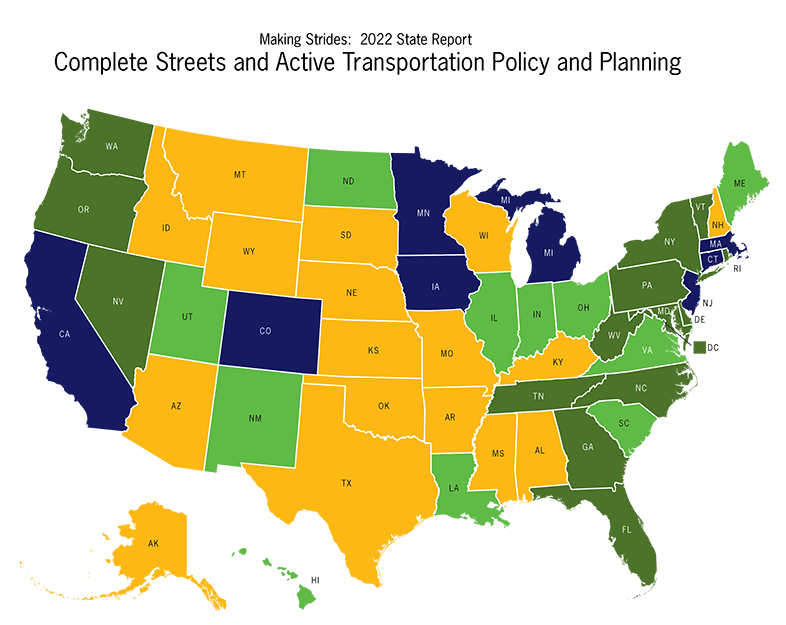We’ve developed state report cards which provide a snapshot of how supportive each state is of walking, bicycling, and physical activity for children and adults as of 2022.
The report cards primarily look at state policy, focusing on four key areas: Complete Streets and Active Transportation Policy and Planning, Federal and State Active Transportation Funding, Safe Routes to School Funding and Supportive Practices, and Active Neighborhoods and Schools. Click on the map to view each state’s report card.

The full report includes a detailed explanation of how the states were graded. Download a quick guide to understanding the report card scores and grading and a fact sheet on how to use your state report card.
Overall scores for core topic areas:
Complete Streets and Active Transportation Policy and Planning | Federal and State Active Transportation Funding | Safe Routes to School Funding and Supportive Practices | Active Schools and Neighborhoods
The maps below show grades and information about key indicators for each state:
Complete Streets: Policy Type and Strength | Transportation Alternatives Program Funding Transfers | High Need Communities | State Funding for Active Transportation | Transportation Funding Grade | SRTS and Non-Infrastructure Funding | School Siting | Physical Education Requirements | Appendices









This map (figure 1 in the report) indicates what type of Complete Streets policy a state has adopted, if any, and how strong the state’s Complete Streets policy is according to the National Complete Streets Coalition’s analysis. Overall, 36 states have some form of Complete Streets policy in place, with DOT policies being the primary tool that states rely on to put in place Complete Streets at the state level.


This map (figure 2 in the report) shows how states are doing in terms of amount of money transferred out of the federal Transportation Alternatives Program (TAP) funding received. Compared to 2020, states are transferring more funds away from TAP, shifting resources away from biking and walking and towards road and bridge projects. Prior to 2022, no state had transferred more than 50 percent of their TAP funds out of the program, and this year, six states fell into this category. The number of states transferring less than 10 percent of TAP funding remained steady at 25 states.


This map (figure 3 in the report) indicates whether states provide either special consideration and/or matching funds for high need communities in allocating TAP funding. The number of states who utilize an equity consideration when awarding TAP projects has been growing. We first included this indicator in 2018, and 16 states prioritized high-need communities that year. In 2020, 21 states did so, and now in 2022, we observe a further increase to 24 states. The number of states that provide matching funds for projects benefiting low-income communities remained steady at 17 states from 2020 to 2022.


The percentage of states funding active transportation with state revenue remained steady since 2020 - sixty percent of states are dedicating their own money for walking, biking, and/or Safe Routes to School. The two-year average for annual state spending on active transportation jumped from $430 million to $612 million, demonstrating that states continue to invest significant state money to support and promote safe walking and bicycling. Of the 31 states dedicating funding, 20 states increased their per capita spending since 2020.


Nineteen states either provide a scoring preference or set aside TAP funding specifically for Safe Routes to School. As of 2022, 34 states allow funding Safe Routes to School programming, a marked increase from 23 states in 2020. This map (Figure 5 in the report) shows the degree to which states are providing special consideration for Safe Routes to School projects and/or funding non-infrastructure projects.


This map (Figure 6 in the report) indicates whether a state’s school siting guidelines are supportive of walking and bicycling to school. The number of states that include large acreage requirements in their school siting guidelines remains unchanged from 2020, and we regard this as a policy area where there is significant potential for additional state action. Support for walking, bicycling, and physical activity within states’ school design guidelines increased minimally with one state implementing new supportive guidelines.


This map (Figure 7 in the report) shows how states scored in the Physical Education category. Points were assigned based on state regulations around the number of minutes of physical education for each grade range, as well as PE credits required for high school graduation. Since 2020, two states have updated their requirements and now align with the number of weekly minutes of physical education recommended by experts. However, no state is receiving the full 15 points for this indicator and the vast majority are receiving 3 points or fewer.


Tables in appendices of the report summarize scoring for each indicator in each of the core topic areas
by state.
- Appendix A summarizes scoring by state for the indicators in the Complete Streets and Active Transportation core topic area.
- Appendix B summarizes scoring by state for the indicators in the Federal and State Active Transportation Funding core topic area.
- Appendix C summarizes scoring by state for the indicators in the Safe Routes to School Funding and Supportive Practices core topic area.
- Appendix D summarizes scoring by state for the indicators in the Active Neighborhood and Schools core topic area.
- Appendix E summarizes the overall scores and grades by state in 2022.
- Appendix F summarizes minimum acreage requirements for schools at each grade level and each state’s correlating score.
- Appendix G summarizes state support for walking, biking, and physical activity in four key areas within school siting and design guidelines and each state’s correlating score.

